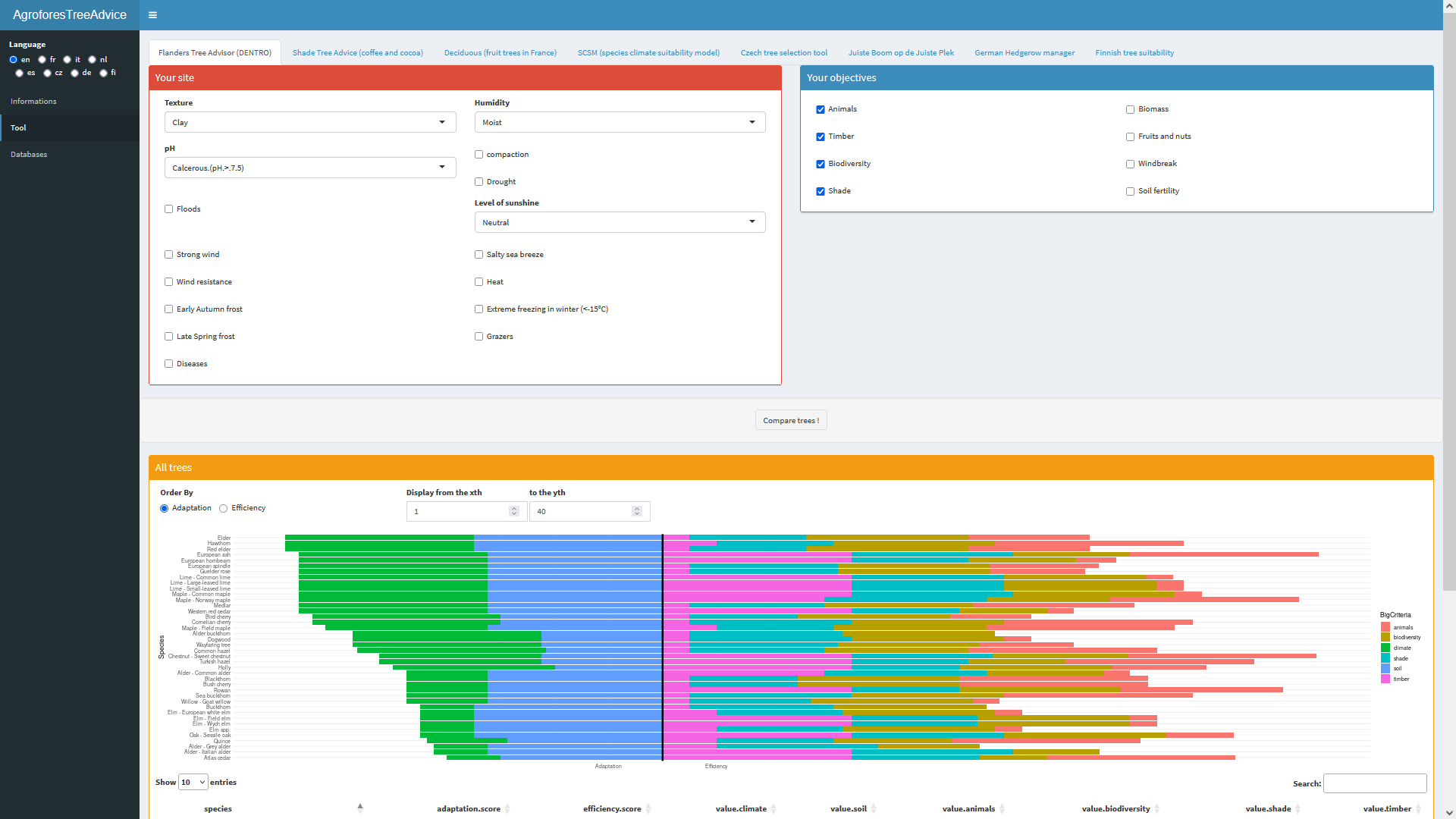AgroforesTreeAdvice: an advice aggregator for tree species selection for agroforestry systems
Oral presentation – EURAF2024 – 28-31 May 2024 – Brno Dr Marie Gosme1, Kristoffer Ronn-Anderson2, Birk Skyum2, Clément Rigal1,3, Raphael Paut4, François Warlop5, Sarah Carton6, Paul Pardon6, Jakub Houska7, Jan Weger7, Lubos Úradníček8, Antonín Martiník8, Michael den Herder9, Rico Hubner10, Ana Tomas11, Sonja Kay12, Cécile Antin13, Evert Prins14, Bert Reubens61 ABSys, Univ Montpellier, CIHEAM–IAMM, CIRAD, INRAE, Institut Agro, Montpellier, France2 Regen Farmer, Aakirkeby, Denmark3 CIRAD – UMR Absys / ICRAF – Vietnam country office, Hanoi, Vietnam4 INRAE – UMR Agronomie, Saclay, France5 Research Group for Organic Farming, Avignon, France6 Flanders research institute for agriculture, fisheries and food (ILVO), Belgium7…

Oral presentation – EURAF2024 – 28-31 May 2024 – Brno
Dr Marie Gosme1, Kristoffer Ronn-Anderson2, Birk Skyum2, Clément Rigal1,3, Raphael Paut4, François Warlop5, Sarah Carton6, Paul Pardon6, Jakub Houska7, Jan Weger7, Lubos Úradníček8, Antonín Martiník8, Michael den Herder9, Rico Hubner10, Ana Tomas11, Sonja Kay12, Cécile Antin13, Evert Prins14, Bert Reubens6
1 ABSys, Univ Montpellier, CIHEAM–IAMM, CIRAD, INRAE, Institut Agro, Montpellier, France
2 Regen Farmer, Aakirkeby, Denmark
3 CIRAD – UMR Absys / ICRAF – Vietnam country office, Hanoi, Vietnam
4 INRAE – UMR Agronomie, Saclay, France
5 Research Group for Organic Farming, Avignon, France
6 Flanders research institute for agriculture, fisheries and food (ILVO), Belgium
7 VUKOZ, Průhonice, Czech Republic
8 Mendel University, Brno, Czech Republic
9 European Forest Institute, Joensuu, Finland
10 German Association for Agroforestry e.V. (DeFAF), Germany
11 MVARC, Beja, Portugal
12 Agroscope, Switzerland
13 CIRAD, AMAP, Montpellier, France
14 Louis Bolk Institute, Bunnik, The Netherlands
Tree species selection is a crucial step in the design of agroforestry systems, for which farmers expressed
the need for decision support systems (DSS). A quick search among the partners of the DigitAF Horizon
Europe project (https://digitaf.eu) allowed us to identify several such DSS, which had been developed independently, in different countries and for different agroforestry systems. These include DENTRO (tree
selection for silvoarable and silvopastoral systems in Flanders), ShadeTreeAdvice (shade tree selection for
coffee and cocoa agroforestry systems), SCSM (soil and climate suitability model for a range of trees and
shrubs worldwide), Deciduous (fruit tree rootstock selection in France) and a Czech trees characteristics
database. In this presentation, we present our joint efforts to develop a common framework in which these tools could all fit, in order to increase their i) findability (all tools are gathered in the same place), ii) accessibility (a common interface allows users to query the tools with interfaces having the same look and feel), and iii) interoperability (API requests can be used to query all tools).
Our hypothesis was that all tree selection tools work by matching tree traits to selection criteria defined
by the user in order to provide a suitability score for each tree species, and that the selection criteria, although being different between different tools, could be organised in a structured way to make comparisons between tools possible. We considered that tree suitability depends on i) adaption to local conditions and i) efficiency at providing the desired benefits (tree products and/or ecosystem services (ES). Based on the trait-function-service framework (Violle et al. 2007), we organized the data according to two types of tree traits: response traits (causing the response of the tree to its environment, and so driving its adaptation to local conditions) and effect traits (allowing the tree to perform functions leading to the production of ES, e.g. fulfilling the farmer’s objectives). Criteria linked to the provision of ES (and therefore the matching effect traits) were organized following the CICES 5.1 classification (Haines-Young and Potschin 2018) at the highest levels, and subsequent levels were added when more details were needed (e.g. distinguishing between different uses of wood). In the absence of internationally recognized classification of criteria linked to the adaptation to local conditions, these criteria were organized as adaptation to soil, climate, biotic context, constraints at plot scale, constraints at farm scale and constraints at socio-economic level. As for ES, we classified these criteria in a hierarchical manner, allowing different levels of details according to the focus of each tool. Finally, we developed a shiny app using this common framework to interface with several tree selection tools.
Initial work on the five species/rootstock selection tools mentioned in the introduction proved that the
idea is feasible: the criteria used in each tool were categorized according to the common framework. Table 1 shows the number of criteria of each top category in each tool. The shiny app aggregates the advice of these five tools. It allows users to define their site conditions and objectives, compute the adaptation and efficiency scores of each tree species and visualize the results in graph or table form; it also supports URL requests.
It is available in six languages and can be tested at https://agroforestreeadvice.sk8.inrae.fr/.
After the proof of concept is done, we aim at enlarging the tool contributors beyond the limits of the
DigitAF project. Therefore, we created a repository under EURAF GitHub account (https://github.com/euraf/agroforestreeadvice). The code is open-source and we welcome contributions (adding new languages, adding new tools, improving code). The tool will be tested and further improved within DigitAF Living Labs.
Acknowledgement
The DigitAF project is supported by the European Union Horizon programme (101059794).
Keywords
ecosystem services, online tool, climate, soil characteristics, Agroforestry system, trees, design, Plant species selection
Bibliography
– Haines-Young R, Potschin M (2018) Common International Classification of Ecosystem Services (CICES) V5.1 and Guidance on the Application of the Revised Structure.
– Violle C, Navas M-L, Vile D, et al (2007) Let the concept of trait be functional! Oikos 116:882–892. https://doi.org/10.1111/j.0030-1299.2007.15559.x
More info about the oral presentation related to this abstract to come
Want to know more about this presentation? contact@digitaf.eu
